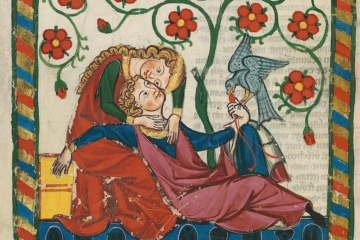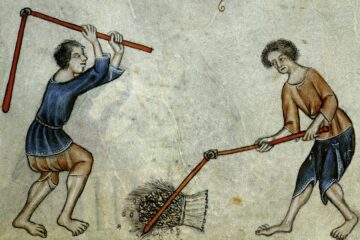The sands of time shift regardless of the wills of the individuals it encompasses. Rarely will we see a man or woman rise to the occasion and stand above the tide to change the course of history. Although not a King or an Emperor, one such man lives in Rosewood; Master Oliver de Rose.
Oliver de Rose was born in Rosewood to a father who served in the former Imperial Army, and a mother who was a renowned tailor. The fifth child of a growing family, it was decided Oliver would join the clergy. As soon as he came of age, he took the cloth and eventually became ordained. His exceptional performance allowed him to be chosen as one of the lucky few in the Rosewood clergy that would be able to attend the University. While his peers chose the obvious subject of Theology, Oliver had an affinity for illuminations when transcribing and so he chose to study Geometry and the Liberal Arts. After six years, he emerged with an in-depth understanding of lineature, symmetrical and asymmetrical shapes, as well as a keen interest in human anatomy. His education, paired with his mother’s teachings on the mixing of dyes, enabled him to become a master of illuminations, murals, mosaics, frescos, and church stained glass art.
In the year 1222, he was named the Court Painter for the Sirius Dynasty after a falling out with the Church over the direction he wanted to take his art in. The general consensus is that art is meant to glorify the Lord and preserve key moments, meaning art is minimalist, broad, and didactic in a Biblical sense. However, De Rose subverts this convention by focusing on the techniques of the ancient Romans and Greeks, instead turning the attention of his artworks to the human figure, who he claims “is God’s creation and as such deserves veneration.” By using quality materials supplied directly by the Royal Crown, Master Oliver was able to create stunning frescos within St. Leena’s, the Bathhouse, the Mayorly Palace, and is currently working on redecorating the walls of Fernyard Fortress.
This shift in art is not exclusive to painting, as music, drama, and fashion have taken a turn that the Church does not exactly approve of. The Papist elements within the Rosewood archdiocese cry out over an oncoming age of amorality among the denizens of the Capital. The Church’s hold over the arts in Rosewood is slowly slipping, but many see it as a positive change. Music has started to merge instrumental and vocal songs together, there is a strong emphasis on pastoral poetry and the vernacular, women are encouraged to sing and considered to be better at it than men, public shows have started to pop up around Rosewood with women, for example, singing while accompanied by a band of instruments. These troupes eventually invaded the drama scene as well.
Plays have been under the jurisdiction of the Church for the better part of the last few centuries. However, as of recently, the first secular stage troupe has started to perform in Rosewood. Church plays are still held, depicting episodes from the Bible, morals tied to Christianity, and scenes from history. However, the secular plays of the Golden Rose Troupe have become a hit and a regional phenomenon for performing plays that are meant to entertain and explore new artistic forms of expression. They also employ women for the actual roles of women, something the clergy is strictly opposed to.
Fashion within the City of Rosewood is the most controversial topic of the age. The men and women of the Capital are recognizable in any part of the Kingdom due to the manner of their dress. The men are known for their tight-fitting attire that has become shorter in length, and their baggy trousers which have started to replace the traditional hosen. This, combined with the advent of the Rosewoodian boot, serves as a symbol of progress that the Church believes is happening too fast, and without its approval. However, the largest issue has arisen from the way women dress. The traditional kirtle has shortened and turned into the jucotte, a figure-hugging kirtle with curved seams, laced up at the front or back, with a broader neckline, shorter sleeves, and a shorter skirt that falls to the knees. This, combined with the remnant of the Saxon invasion and the general influences from Nordic Christianity, where women are not forced to cover their hair when married, has shaped Rosewoodian female fashion into something the rest of the continent are worried about. This has sparked myths about the beauty of Rosewoodian women, as well as the wealth of its men. These outrageous liberties could have been curbed by a strong Royal authority, however, during this trying period of artistic experimentation, France got its first Queen; one that wasn’t even meant to rule. She worked to strengthen artistic expression, taking their side over the Papal authority in Rome, and she wholeheartedly supported the movement to grant the women of the Capital broader rights in everyday life. As King Torrino III has taken the throne, this movement has shown no signs of stopping or slowing down.
Master Oliver de Rose remains the primary figure of this movement which aims to focus on the human realm, instead of the divine. He has had interactions with multiple thinkers from the German countries, England, Spain, the lands of northern Italy, and the Byzantine court, further spreading this idea down the silk road and beyond. Of course, this movement is regarded as a philosophical movement and is usually called the Oliverian School of Thought or Oliverianism. However, in a couple of centuries, this moment in history will be regarded as the intellectual and spiritual ancestor to a much broader movement that swept across Europe, Humanism.


